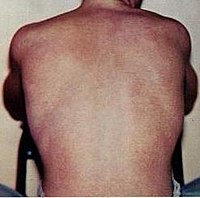
Photo from wikipedia
The purpose of this study was to evaluate the effects of developing and using a model to predict dengue risk in villages and of a larval indices surveillance system for… Click to show full abstract
The purpose of this study was to evaluate the effects of developing and using a model to predict dengue risk in villages and of a larval indices surveillance system for 2372 households in 10 Thai villages. A community participatory action research method was used in five steps: (1) community preparation covering all stakeholders, (2) assessment of the understanding of a dengue solution and a larval indices surveillance system, (3) development of a prediction and intervention model for dengue risk villages, (4) implementation of the model that responds to all stakeholders, and (5) evaluation of the effects of using the model. The questionnaires to assess and evaluate were validated and reliability tested. The chi-square test and Fisher’s exact test were used to analyze the quantitative data collected by means of questionnaires. Thematic analysis was applied to the qualitative data collected through interviews. The results found that the model consisted of six main activities, including (1) setting team leader responsibility, (2) situation assessment, (3) prediction of the dengue risk in villages, (4) the six steps of the larval indices surveillance system, (5) the understanding of the dengue solution and the understanding of the larval indices surveillance system training program, and (6) local wisdom innovation. The effects of using the model showed a statistically significant increase in correct understanding among 932 family leaders, 109 village health volunteers, and 59 student leaders regarding dengue prevention and control (p < 0.05). The larval indices and dengue morbidity were diminished and related to the nine themes present in the community leaders’ reflections and to the satisfaction of the community members. Hence, local administrative organizations should use community-based approaches as the subdistrict dengue solution innovation to reduce the dengue problem.
Journal Title: International Journal of Environmental Research and Public Health
Year Published: 2022
Link to full text (if available)
Share on Social Media: Sign Up to like & get
recommendations!